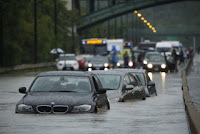By:
Gina Yang
Writing Grade 9-10
“We’re struggling to keep things like the TTC up and running and hospitals up and running,” Haines said on CP24 in Toronto. The July 8, 2013 storm ranks as the most costly natural disaster in the province's history, resulting in over 850 million dollars in property damage, according to CBC news. Despite this, not much effort has been made to deal with the infrastructural problems that led to the extensive flooding that caused the bulk of the damage.
Although some question the effectiveness of sewage and drainage system upgrades, believing that they'll only serve to increase the already enormous debt held by the city, they can help to alleviate future flood damage as well as improve the functionality of the city during intense storms. ImprovingToronto
Although some question the effectiveness of sewage and drainage system upgrades, believing that they'll only serve to increase the already enormous debt held by the city, they can help to alleviate future flood damage as well as improve the functionality of the city during intense storms. Improving
The record
breaking downfall of rain caused major sewerage lines to be backed up which
resulted in thousands of flooded basements. By July 26, 2013, about 4500
calls had been made to Toronto Water regarding flooded basements.
“Tanya Morgado, who commutes fromMississauga , Ont., to downtown
Toronto
Currently, according to the Huffington Post, insurers warned that consumer’s insurance bill may rise due to the 850 million dollars in damage as a consequence, strengthening the sewerage system would save people lots of money seeing that home damage would be reduced.
“Tanya Morgado, who commutes from
Currently, according to the Huffington Post, insurers warned that consumer’s insurance bill may rise due to the 850 million dollars in damage as a consequence, strengthening the sewerage system would save people lots of money seeing that home damage would be reduced.
The intense
flooding caused by the storm resulted in the closure of many roads and
highways, including the Don Valley
Parkway
Although there
are numerous solutions, the most straightforward and effective choice would be
to simply bring back underground rivers. These underground rivers are designed
to relieve stress on the drainage in times on high water traffic. Yet, this
idea is outdated and clearly cannot manage the heavy precipitation as shown from
July 2013.
Michael Cook, a graduate student in landscape architecture at theUniversity
of Toronto Toronto Seoul
Michael Cook, a graduate student in landscape architecture at the
Spending over 900 million dollars to improve Toronto Toronto
